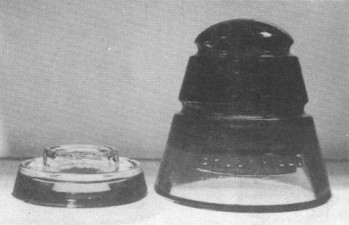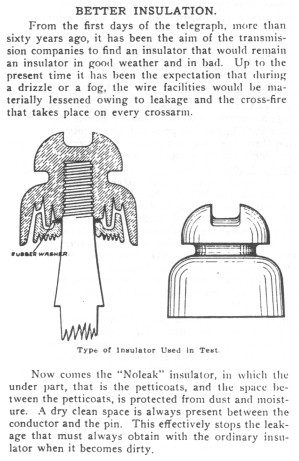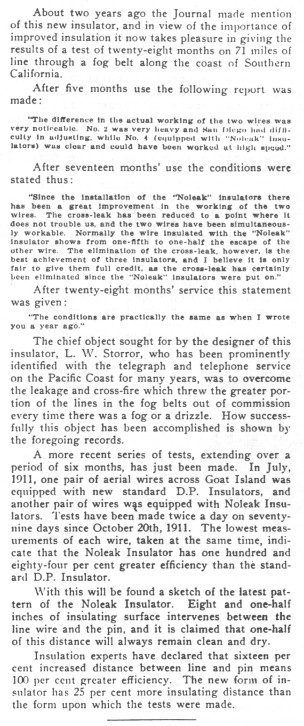The CD-211 Brookfield Noleak D
by Elton Gish
Reprinted from "Crown Jewels of the Wire", May 1986, page 32
You must be asking, 'What is a mud collector doing writing about glass".
Well, this mud collector started out collecting Brookfields and I still have a
soft spot for something to sit in a window and look pretty, not that Brookfields
are all that colorful. But, I do have a niche among all the mud that is reserved
for glass.
Last summer I visited several collectors in the Seattle area and could not
resist getting a Brookfield NOLEAK D with glass insert from Winslow Trueblood.
He had painstakingly dug several of these along an old line in the mountains east of Seattle.

The glass inserts were rarely found
undamaged and I felt fortunate to get one in good condition. Then, on one of the
many trips I made last year to several Texas universities to research old trade
journals for articles on mud, I accidentally found an article on the NOLEAK D.
The article was in an issue of the "Journal of Electricity, Power and
Gas" dated February 10, 1912, page 12. I searched every issue prior to that
article trying to find the reference, "About two years ago the Journal made
mention of this new insulator...'.. The only reference that I could find was a patent summary in the issue dated
April 11, 1908.
The test results, if they can be believed, are quite convincing. Note in the
last paragraph that the article refers to two forms of the Noleak insulator. Of
course, sketches of insulators in these early articles are seldom accurate, so
we may never know what the first units actually looked like.
Following the article is a copy of the March 24, 1908 patent #882,803.
The Pacific Coast Highway will probably be congested with collectors looking
for the Noleak insulator described in those tests and don't expect to find many
available boats to Goat Island either. Happy hunting.

Large Image (133 Kb) |
(image text)
BETTER INSULATION
From the first days of the telegraph, more than sixty years ago, it has
been the aim of the transmission companies to find an insulator that would
remain an insulator in good weather and in had. Up to the present time it has been
the expectation that during a drizzle or a fog, the wire facilities would be materially lessened owing to leakage and the
cross-fire that takes place on
every crossarm.
Type of Insulator Used in Test.
Now comes the "Noleak" insulator, in which the under part, that
is the petticoats, and the space between the petticoats, is protected from
dust and moisture. A dry clean space is always present between the conductor
and the pin. This effectively stops the leak age that must always obtain with
the ordinary insulator when it becomes dirty.
|

Medium Image - 104 Kb
Large Image - 244 Kb |
(image text)
About two years ago the Journal made mention of this new insulator, and in
view of the importance of improved insulation it now takes pleasure in giving the results of a test of twenty-eight months on 71
miles of line
through a fog belt along the coast of Southern California.
After five months
use the following report was made:
"The difference in the actual working of the two wires was very
noticeable.
No. 2 was very heavy and San Diego had difficulty in adjusting, while No. 4
(equipped with "Noleak" insulators) was clear and could have been
worked at high speed."
After seventeen months' use the conditions were stated thus:
"Since the Installation of the "Noleak" insulators there has
been a great improvement in the working of the two wires. The cross-leak has been reduced to a point
where it does not trouble us, and the two wires have
been simultaneously workable. Normally the wire insulated with the "Noleak"
Insulator shows from one-fifth to one-half the escape of the other wire. The
elimination of the cross-leak, however, is the best achievement of these
insulators, and I believe it is only fair to give them full credit. as the
cross-leak has certainly been eliminated since the "Noleak"
insulators were put on."
After twenty-eight months' service this statement was given:
"The
conditions are practically the same as when I wrote you a year ago."
The chief object sought for by the designer of this insulator, L. W. Storror, who has been prominently
identified with the telegraph and telephone
service on the Pacific Coast for many years, was to overcome the leakage and
cross-fire which threw the greater portion of the lines in the fog belts out of
commission every time there was a fog or a drizzle. How successfully this
object has been accomplished is shown by the foregoing records.
A more recent
series of tests, extending over a period of six months, has just been made. In
July, 1911, one pair of aerial wires across Goat Island was equipped with new
standard D.P. Insulators, and another pair of wires was equipped with Noleak
Insulators. Tests have been made twice a day on seventy-nine days since
October 20th, 1911. The lowest measurements of each wire, taken at the same
time, indicate that the Noleak Insulator has one hundred and eighty-four per
cent greater efficiency than the standard D.P. Insulator.
With this will
be found a sketch of the latest pattern of the Noleak Insulator. Eight and
one-half inches of insulating surface intervenes between the line wire and the
pin, and it is claimed that one-half of this distance will always remain clean
and dry.
Insulation experts have declared that sixteen percent increased
distance between line and pin means 100 percent greater efficiency. The new form of
insulator has 25 per cent more insulating distance than the form
upon which the tests were made.
|
|
